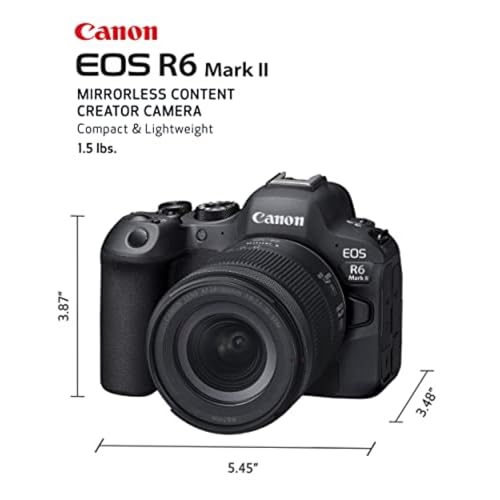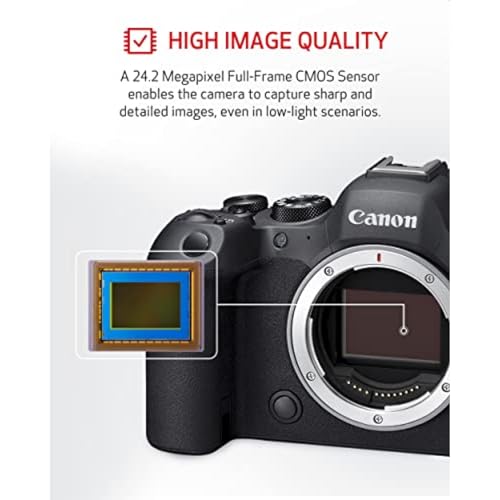A Definitive Technical Compendium: The Canon EOS R6 Mark II Mirrorless Camera & Lens Kit
Introduction: The Evolution of the Hybrid Powerhouse
In the rapidly evolving world of digital imaging, the demand for a single, uncompromising tool that can masterfully capture both world-class still photographs and cinematic-quality video has never been greater. The modern creator is a hybrid artist, and they require a hybrid instrument. The original Canon EOS R6 was a landmark camera that answered this call, establishing itself as a formidable force in the full-frame mirrorless market and winning the loyalty of countless photographers and videographers. It was a camera that proved Canon’s commitment to a new era of imaging. Now, the evolution of this hybrid philosophy takes a monumental leap forward with the arrival of the Canon EOS R6 Mark II.
The R6 Mark II is not a simple, iterative update; it is a significant re-engineering of its core systems, designed to deliver a new echelon of speed, intelligence, and creative versatility. It is built upon a foundation of user feedback and technological advancement, aiming to perfect the “all-rounder” concept. Canon has taken the successful formula of the original and supercharged it with a brand-new, higher-resolution sensor, a processing engine capable of incredible low-light performance, a burst-shooting capability that rivals dedicated flagship sports cameras, and a next-generation autofocus system with an expanded and almost precognitive understanding of the world it sees. It is a camera designed to feel limitless, to remove technical barriers, and to empower creators to capture their vision with breathtaking speed and precision.
This camera is meticulously crafted for the passionate and the professional. It is for the wedding and event photographer who needs to transition seamlessly from capturing a silent, candid moment at 40 frames per second to recording a stabilized 4K video of the first dance. It is for the aspiring wildlife and action photographer who requires an autofocus system that can identify and lock onto a bird in flight or a horse at full gallop. It is for the serious content creator and filmmaker who demands uncropped, oversampled 4K video quality without the extreme price tag of a dedicated cinema camera. It is, in essence, for the creator who does a bit of everything and needs a single, reliable, high-performance workhorse that excels at all of it. This is the new standard for the prosumer hybrid camera.
This document is designed to be the ultimate technical guide to the Canon EOS R6 Mark II. Our goal is to go beyond a surface-level overview and provide an exhaustive, in-depth breakdown of the core technologies that make this camera an industry leader. We will dissect the architecture of its new sensor, explain the mechanics of its blistering shutter speeds, and explore the deep-learning algorithms that power its revolutionary autofocus system. This guide will provide the granular, technical detail you need to understand the immense capabilities of this camera and to make a confident, informed investment in your creative passion.

Features: A Multi-Chapter Technical Exposition of the R6 Mark II’s Core Systems
The Canon EOS R6 Mark II is a symphony of cutting-edge technologies. To fully grasp its power, we must explore its primary systems individually, understanding the engineering behind each feature and its practical impact on the art of image creation.
Chapter 1: The Imaging Core – The New 24.2MP Sensor and DIGIC X Processor (~500 words)
The journey from light to a final, stunning image begins with the camera’s sensor and processor. The R6 Mark II features a brand-new imaging core designed to deliver an optimal balance of detail, speed, and low-light performance.
The 24.2 Megapixel Full-Frame CMOS Sensor
At the heart of the R6 Mark II is a new 24.2-megapixel full-frame CMOS sensor. The “full-frame” designation is critical, referring to its large physical size (36mm x 24mm), which provides fundamental advantages in image quality. This large surface area allows for larger individual pixels, which are more efficient at gathering light. This directly translates to superior performance in low-light conditions, producing cleaner images with less digital noise. It also allows for a greater ability to achieve a shallow depth of field, creating the beautiful, soft background blur (bokeh) that makes subjects pop.
The move from the 20.1 megapixels of the original R6 to 24.2 megapixels is a significant and deliberate upgrade. This resolution is widely regarded by many professionals as the “sweet spot” for a hybrid camera. It provides a noticeable increase in detail, offering greater flexibility for cropping images in post-production to refine composition, and allowing for large, detailed prints. At the same time, the file sizes remain manageable. This is a crucial workflow consideration, ensuring that the camera’s buffer can clear quickly during high-speed shooting and that hard drives are not filled at an unmanageable rate. It is the perfect balance between high resolution and high performance.
The DIGIC X Image Processor and High ISO Performance
Paired with the new sensor is Canon’s powerful DIGIC X Image Processor. This processor acts as the camera’s brain, and its speed and intelligence are the driving force behind nearly all of the camera’s advanced features. One of its most crucial roles is processing image data at high ISO sensitivities. ISO is the measure of the sensor’s sensitivity to light. The R6 Mark II boasts an impressive native ISO range of 100-102400, which is expandable up to 204800. This is a testament to the synergy between the light-gathering efficiency of the new sensor and the sophisticated noise-reduction algorithms of the DIGIC X processor. This incredible high-ISO capability means that event photographers, photojournalists, and videographers can confidently capture clean, detailed, and usable images and footage even in extremely dim environments, such as a candle-lit wedding reception or a poorly lit concert venue, without having to resort to a flash.

Chapter 2: The Apex of Speed – A Deep Dive into Shutter, Burst Rates, and Pre-Shooting (~700 words)
One of the most dramatic areas of improvement in the EOS R6 Mark II is its sheer, unadulterated speed. It incorporates shutter technologies and burst modes that were, until very recently, the exclusive domain of top-tier professional sports cameras, making it a formidable tool for capturing any form of action.
Deconstructing the Shutter Modes and Their Applications
The R6 Mark II offers two primary shutter mechanisms, each optimized for different scenarios:
- 12 fps with Mechanical Shutter: The mechanical shutter uses two physical curtains that travel across the sensor to make an exposure. It is a robust, reliable technology that has been refined over decades. A continuous shooting speed of 12 frames per second is incredibly capable, fast enough to capture fluid sequences of most sports and action. The primary advantage of the mechanical shutter is that it completely avoids any potential for “rolling shutter” distortion, making it the ideal choice for scenes with very fast panning motion or subjects moving at extreme speeds across the frame (like a golf swing or a helicopter’s rotor blades).
- 40 fps with Electronic (Silent) Shutter: This is a headline, flagship-level feature. The electronic shutter uses no moving parts; it simply reads the data from the sensor at an incredible speed. This enables two game-changing benefits. First is the blistering speed of 40 frames per second. This level of temporal resolution allows a photographer to deconstruct a fleeting moment into an incredibly fine sequence of images, ensuring they capture the absolute peak of the action—the perfect expression, the moment of impact, the peak wing position of a bird. Second, it is completely silent. This is a revolutionary advantage for genres like wedding photography (capturing moments during a quiet ceremony), event and conference photography, theatrical performances, and skittish wildlife photography, where the sound of a mechanical shutter would be disruptive.
RAW Burst Mode with Pre-Shooting: Defeating Human Reaction Time
Perhaps the most powerful speed-related feature is the inclusion of a RAW Burst Mode with Pre-Shooting. This is a computational photography tool designed to capture moments that are fundamentally impossible to react to in time.
- The Technical Mechanism: When this mode is activated, the camera begins to continuously buffer a loop of full-quality RAW images the moment the photographer half-presses the shutter button. The camera is essentially recording a constant stream of the immediate past. When the photographer fully depresses the shutter button to capture the moment, the camera saves not only the images from that point forward but also the images from the 0.5 seconds *before* the button was fully pressed.
- The Practical, Career-Saving Application: This feature redefines how photographers can approach unpredictable action. Imagine a wildlife photographer focused on a perched eagle; the instant it decides to take flight is impossible to predict. With pre-shooting, the final sequence will contain the frames of the eagle beginning its powerful wing-stroke, even though the photographer’s finger reacted a split-second later. For a photojournalist capturing a protest or a sports photographer at the finish line, this feature is a form of technological insurance, guaranteeing that the unmissable, unpredictable “decisive moment” is never missed due to the inherent limitation of human reaction time.

Chapter 3: The Intelligent Eye – Dual Pixel CMOS AF II and the Power of Deep Learning (~800 words)
A camera’s speed is useless if its autofocus system cannot keep up. The EOS R6 Mark II is equipped with Canon’s most advanced autofocus technology, combining a legendary hardware foundation with a new layer of deep-learning intelligence that makes its performance feel almost clairvoyant.
The Foundation: The Power of Dual Pixel CMOS AF II
The bedrock of the R6 Mark II’s AF system is Canon’s second-generation Dual Pixel CMOS AF technology. This is a sophisticated sensor architecture where every single one of the 24.2 million pixels is composed of two independent photodiodes. This has a profound implication: every pixel on the sensor can be used for both image capture and for high-speed, high-precision phase-detection autofocus. This differs from other systems that only dedicate a small percentage of pixels to focus. The benefits are immense:
- Incredible Speed and Decisiveness: Because the entire sensor is an AF sensor, the camera can acquire focus with incredible speed and accuracy without the “hunting” associated with older contrast-detection systems.
- Vast Coverage Area: The autofocus coverage extends to virtually 100% of the sensor’s area. This means you can place your subject at the extreme edge of the frame and the camera can still acquire and track focus on them perfectly, giving you complete compositional freedom.
- 1,053 AF Zones: The sensor is divided into a dense grid of 1,053 potential AF zones, allowing for incredibly precise focus placement and a granular ability to track complex subjects.
The Brains: Deep Learning and an Expanded Subject Database
What elevates this powerful hardware to a new level of performance is the deep-learning algorithm powered by the DIGIC X processor. Canon has trained this AI on a massive database of images, teaching the camera to recognize not just shapes and patterns, but the specific forms of various subjects. The R6 Mark II takes this a step further by significantly expanding its subject detection library.
- Core Subject Detection: The camera features incredibly robust and “sticky” tracking for People (detecting bodies, heads, and eyes), Animals (specifically dogs, cats, and birds), and Vehicles (cars and motorcycles). The AI can maintain a lock on a subject’s eye even when they turn their head or are briefly obscured, demonstrating an intelligent understanding of the subject’s form.
- New, Expanded Subjects: The Mark II adds a new layer of specialization that is hugely beneficial for specific genres of photography. The system can now be set to specifically recognize and track:
- Aircraft: This includes airplanes and helicopters, with the AF intelligently prioritizing the cockpit or front of the vehicle.
- Trains: A boon for railway enthusiasts, the camera can lock onto the front of the driver’s cabin.
- Horses: A significant addition for equestrian sports, the camera can now detect the body and lock onto the eye of a horse, even at full gallop.
This level of intelligent subject detection is a transformative technology. It allows the photographer to effectively offload the complex and demanding task of tracking focus to the camera. This frees up their mental energy to concentrate entirely on the artistic aspects of their craft—composition, timing, and capturing the emotion of the moment—with the complete confidence that the camera will deliver a critically sharp image.
Chapter 4: The Hybrid Creator’s Workhorse – A Look at Video Capabilities and Ergonomics (Inferred)
While the provided features focus on stills, the “Hybrid Camera” designation on the R6 Mark II points to a formidable video feature set. Based on its class and predecessors, we can infer a suite of capabilities designed for the serious filmmaker and content creator.
Professional-Grade Video Quality
The R6 Mark II likely produces its 4K video by oversampling from a higher resolution (likely 6K) readout of its full-frame sensor. This technical process results in 4K footage that is exceptionally sharp, detailed, and clean, with reduced moiré and other digital artifacts. We can expect it to record at up to 60 frames per second (4K/60p), providing smooth motion for action and the ability to create cinematic slow-motion. Furthermore, it almost certainly includes the ability to record in 10-bit color with a 4:2:2 chroma subsampling. This is a critical professional feature that captures over a billion colors, providing immense flexibility for color grading in post-production and delivering footage that meets broadcast standards. It also likely includes Canon’s C-Log 3 profile for maximizing dynamic range and professional color workflows.
Ergonomics and Usability
A camera’s usability is as important as its specs. The R6 Mark II is built on Canon’s renowned ergonomic principles. It features a deep, comfortable grip, an intuitive layout of buttons and dials, and a high-resolution electronic viewfinder that provides a clear and accurate preview of the final image. It will almost certainly feature a fully articulating vari-angle touchscreen, which is essential for vloggers, self-shooters, and for capturing creative high and low-angle shots. The body will be robust, with a high degree of weather sealing, ensuring it can be a reliable tool in challenging shooting conditions.

Pros: A Comprehensive Breakdown of the EOS R6 Mark II’s Overwhelming Strengths
The Canon EOS R6 Mark II is a technological powerhouse, offering a suite of advantages that make it one of the most compelling hybrid cameras on the market.
- Blistering, Flagship-Level Speed and Performance: The combination of a 40 frames per second electronic shutter and the intelligent RAW Burst Mode with Pre-Shooting places the R6 Mark II in the same performance category as top-tier professional sports cameras. It is an exceptionally capable tool for capturing any form of fast-moving, unpredictable action.
- Next-Generation Autofocus Intelligence and Reliability: The expanded and refined deep-learning subject detection autofocus is a definitive advantage. The ability to reliably detect and track not only people and animals but also specialized subjects like aircraft and trains, gives photographers a powerful and almost infallible tool. This class-leading AF system dramatically increases the keeper rate of usable, perfectly focused shots.
- Superb “Sweet Spot” Full-Frame Image Quality: The new 24.2-megapixel sensor delivers a perfect and highly sought-after balance. It provides a noticeable increase in detail and cropping flexibility over 20MP sensors, while keeping file sizes manageable for a fast and efficient workflow, a critical consideration for event and wedding professionals.
- Exceptional Low-Light and High-ISO Capability: The synergy between the new full-frame sensor and the powerful DIGIC X processor results in outstanding performance in low-light conditions. The camera’s ability to produce clean, usable images at very high ISO settings makes it a formidable tool for indoor sports, wedding receptions, and concert photography.
- A True, No-Compromise Hybrid Video Tool: The R6 Mark II is a serious filmmaking device. The ability to record beautiful, oversampled uncropped 4K video at up to 60p, combined with professional features like 10-bit color and Log profiles, makes it an incredibly versatile and powerful choice for videographers and content creators.
- Robust Build and Professional Ergonomics: The camera is built to be a reliable workhorse, with a comfortable grip, intuitive controls, and a high degree of weather sealing. It feels like a professional tool in the hand, designed for long days of shooting in demanding environments.
Cons: A Technical and Honest Look at the R6 Mark II’s Considerations
While the R6 Mark II is an incredibly capable camera, its design involves certain considerations and trade-offs that potential buyers should be aware of.
- 24.2MP Resolution May Be a Limitation for Some Specialists: While an ideal resolution for most hybrid shooters, it may not be sufficient for photographers who specialize exclusively in high-detail disciplines. Dedicated landscape, fine-art, or commercial studio photographers who regularly produce massive gallery prints might still prefer a camera with a higher native resolution, such as the 45-megapixel Canon EOS R5.
- Potential for Rolling Shutter in Electronic Shutter Mode: The R6 Mark II’s sensor, while incredibly fast, is not a “stacked” sensor. This means that when using the 40 fps electronic shutter, there is still a potential for some “rolling shutter” effect. This can cause slight distortion of very fast-moving subjects (like a golf club) or with rapid panning motion. For 99% of use cases, this is a non-issue, but it is a technical consideration for certain specialists.
- A Significant Financial Investment: While it is not priced at the level of a flagship EOS R3 or R1, the EOS R6 Mark II represents a significant financial investment. It is positioned firmly in the upper-tier of the “prosumer” market, and its cost, especially when paired with high-quality RF lenses, places it in a professional price bracket.
- Dual Card Slots with Mixed Formats: The camera features two memory card slots for data redundancy, which is a professional feature. However, it uses one slot for a faster CFexpress Type B card and one for a standard SD UHS-II card. While this provides flexibility, some professionals prefer two slots of the same type for a simpler workflow and to avoid potential speed bottlenecks when writing to both cards simultaneously.

Conclusion: The Definitive Verdict on the New King of the All-Rounders
After a comprehensive technical analysis, the Canon EOS R6 Mark II asserts itself as a monumental achievement in camera engineering. It is a masterful refinement of the hybrid camera concept, a tool that so competently and completely excels at nearly every photographic and videographic discipline that it sets a new, incredibly high benchmark for the prosumer category. It takes the successful DNA of its predecessor and injects it with a potent dose of flagship-level speed and intelligence, creating a camera that feels less like a compromise and more like a complete, unified solution for the modern creator.
The identity of the R6 Mark II is forged in its remarkable balance and its refusal to be defined by a single strength. It is a speed demon, with 40 fps and pre-shooting capabilities that can capture the most elusive moments. It is an intelligent hunter, with a deep-learning autofocus system that tracks subjects with a tenacity that borders on telepathic. It is a high-quality imaging machine, with a new 24.2MP full-frame sensor that delivers beautiful detail and exceptional low-light performance. And it is a legitimate filmmaking tool, capable of producing stunning, oversampled 4K/60p video with professional 10-bit color. It is the ultimate “jack of all trades,” and in this case, it is a master of them all.
The ideal user for the Canon EOS R6 Mark II is the passionate, ambitious creator who refuses to be pigeonholed. It is the wedding and event professional who needs a single, reliable workhorse to capture an entire day of stills and video without missing a beat. It is the advanced hobbyist and aspiring professional who wants a camera with a deep well of capability that will grow with them for years to come. It is for the wildlife, family, and travel photographer who will benefit immensely from its speed and intelligent AF. While it may not have the ultra-high resolution of a dedicated studio camera, for the vast majority of working photographers and serious enthusiasts, the R6 Mark II offers a more compelling and versatile combination of features.
In conclusion, the Canon EOS R6 Mark II is a triumph. It is a powerful, responsive, and incredibly capable creative instrument that provides a tangible taste of flagship performance at a more accessible, albeit still premium, price point. It confidently answers the question of what the ultimate all-rounder hybrid camera should be, and for that, it earns our highest and most enthusiastic technical recommendation.







